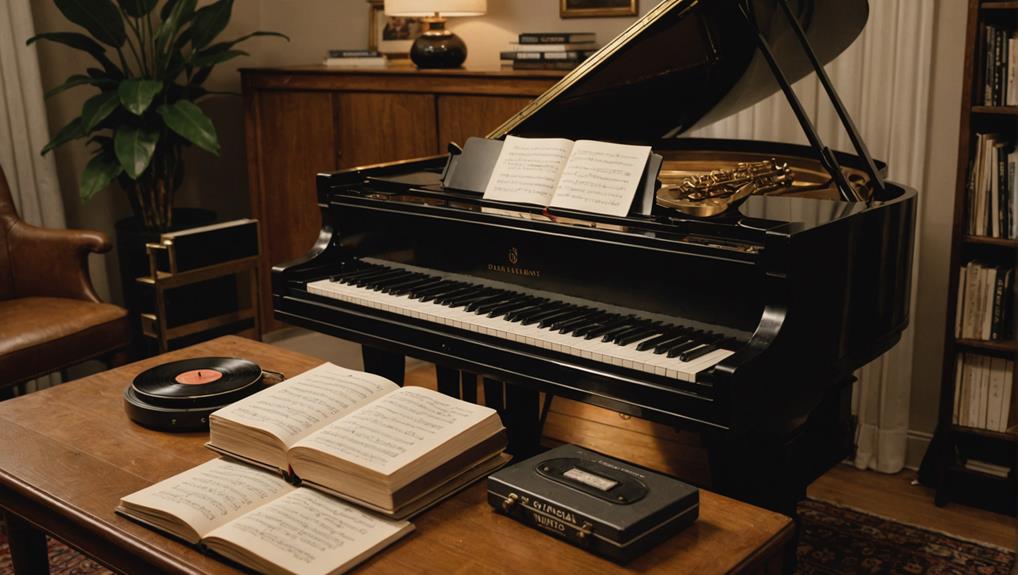Mastering the 7/8 time signature involves understanding its unique structure of 7 beats per measure, often divided into 2+2+3. Count out loud using ‘1, 2, 1, 2, 1, 2, 3’ to internalize the rhythm. Start slow and use a metronome for precise timing. Experiment with emphasizing different beats to create dynamic rhythms. Shifting from 4/4 to 7/8 can be tricky, so practice regularly and increase your speed gradually. Familiarize yourself by listening to songs in 7/8. By exploring these techniques, you’ll soon feel more confident with this complex time signature. There’s much more to uncover about mastering 7/8 time!
Key Takeaways
- Count the beats in subdivisions of 2+2+3 for better internalization.
- Practice out loud: ‘1, 2, 1, 2, 1, 2, 3’ to establish the rhythm.
- Use a metronome to maintain a steady tempo and rhythmic accuracy.
- Experiment with accenting different beats to understand dynamic rhythms.
- Start slow and gradually increase speed to ensure precision and clarity.
Understanding 7/8 Time
Understanding 7/8 time starts with recognizing that it consists of 7 beats per measure, typically divided into groups of 2 + 2 + 3. This division creates a unique rhythmic pattern that can be both intriguing and challenging.
To grasp this time signature, you need to focus on the accentuation and the emphasis within these groupings. Syncopation challenges often arise because the uneven grouping can disrupt the regular flow you’re used to in more common time signatures.
To count 7/8 effectively, try subdividing the beats into eighth notes. This approach will help you clearly identify the groups of 2 + 2 + 3. Start by counting aloud: ‘1-2, 1-2, 1-2-3.’ This method will reinforce the natural accents and make it easier to internalize the rhythm.
Tempo fluctuations can complicate things further, as maintaining a steady tempo in 7/8 requires precision and practice.
Listening to songs in 7/8 time can also be beneficial. Familiarizing yourself with these rhythms will develop a natural feel for the time signature.
Breaking Down Beats
To break down the beats in 7/8 time, start by focusing on the subdivisions of 2+2+3 to clearly identify the rhythmic structure. This specific beat division helps you grasp the flow of the time signature. Begin by counting out loud: ‘1, 2, 1, 2, 1, 2, 3.’ Notice how this rhythmic subdivision groups the beats into two sets of 2 and one set of 3.
Breaking down the beats into eighth notes is essential for maintaining the rhythm. By treating each subdivision as its own mini-section, you can keep the pulse consistent. Practice counting each subdivision separately: ‘1, 2,’ ‘1, 2,’ and ‘1, 2, 3.’ Then, put them together smoothly. This will help you internalize the beat divisions and make handling 7/8 time more intuitive.
Maintain a steady pulse while counting to enhance your rhythmic accuracy. Use a metronome if needed to keep you on track. With consistent practice, you’ll find that breaking down the beats in 7/8 time becomes second nature.
This methodical approach ensures you’re not just counting but feeling the rhythm, making your performance more precise and confident.
Syllable Counting
When practicing 7/8 time, count each beat with single syllables like ‘one, two, three, four, five, six, seven’ to maintain rhythm clarity. Focusing on one syllable emphasis for each eighth note guarantees your timing remains accurate. This method helps you avoid the confusion that might arise from using two-syllable counts. By counting each eighth note individually, you create a clear and consistent pulse, essential for mastering the 7/8 time signature.
To enhance rhythmic clarity, always prioritize syllable precision. Misplacing even a single beat can disrupt the overall timing accuracy. Practicing with one-syllable counts keeps your rhythm tight and your beats well-defined. It’s particularly useful when you’re working on complex chord progressions or intricate melodic lines in 7/8 time. Each beat stands out clearly, making it easier to follow and less likely to be lost in the mix.
Consistent pulse and syllable precision are key. You’ll find that using this counting technique simplifies the process, providing a solid foundation for your rhythmic understanding. With practice, your ability to navigate the nuances of 7/8 time will improve, leading to more confident and precise performances.
Transitioning From 4/4
After mastering syllable counting in 7/8 time, you can start by recognizing the shift from the familiar 4/4 beat structure to the more complex 7-beat grouping. In 4/4, beat emphasis typically falls on the first and third beats, creating a steady and predictable rhythm. However, in 7/8, the emphasis changes, often falling on beats like 1, 4, and 6, which creates a more irregular feel.
Understanding this change is essential for effective tempo control. Start by breaking down the 7/8 time signature into smaller, manageable patterns such as 2+2+3 or 3+2+2. This subdivision helps you internalize the new beat structure and adjust your playing or counting rhythm accordingly.
| Time Signature | Beat Emphasis |
|---|---|
| 4/4 | 1 and 3 |
| 7/8 (2+2+3) | 1, 3, and 5 |
| 7/8 (3+2+2) | 1, 4, and 6 |
Experiment with simple melodies or chord progressions in 7/8 to solidify your understanding. Gradually increase the tempo as you become more comfortable, ensuring you maintain control over the beat emphasis. This practice will make the shift from the steady 4/4 rhythm to the complex 7/8 meter smoother and more intuitive.
Internalizing the Meter
Start by counting each eighth note aloud to internalize the unique pulse of a 7/8 time signature. By doing this, you’ll start to feel the natural flow and rhythm of this meter. To further enhance your rhythm, try tapping your foot or clapping along with the beat. This physical engagement with the rhythm can greatly improve your timing and help you stay consistent.
Breaking down 7/8 into smaller groups, such as 2+2+3 or 3+2+2, makes the structure more digestible. This method allows you to better understand and internalize how the beats are organized. Use a metronome set to the eighth note subdivision to stay on track. Hearing a steady click will keep your timing precise and make sure you don’t drift off-tempo.
Experiment with different accents and emphasis within the 7/8 pattern. By placing emphasis on different beats, you can develop a deeper connection to the meter. For instance, try accentuating the first note of each grouping (2+2+3) to feel how the rhythm shifts. This practice won’t only improve your rhythm but also make you more versatile in handling complex time signatures.
Practice Techniques
To master counting in 7/8, you should subdivide the beat into eighth notes for greater precision.
Regularly using a metronome will help you maintain a consistent tempo and internalize the unique rhythmic structure.
This approach guarantees you develop a strong sense of rhythm and can shift smoothly between different time signatures.
Subdivide the Beat
Mastering the subdivision of beats in a 7/8 time signature is crucial for developing a strong sense of rhythm and timing. When you subdivide each beat into its individual eighth notes, you guarantee rhythmic accuracy and build a reliable internal pulse. Counting each of the seven eighth notes distinctly (1-2-3-4-5-6-7) allows you to maintain precise counting and avoid losing track of the beat.
To help you get started, consider these practice tips:
- Count aloud: Verbally counting each eighth note helps reinforce the beat subdivision.
- Clap or tap: Physically clapping or tapping each beat can solidify your sense of timing and pulse development.
- Visual aids: Use a score or written notation to visually map out the seven beats, aiding in precise counting.
- Phrase grouping: Group beats into smaller, manageable chunks (e.g., 4+3 or 3+4) to internalize the rhythm more effectively.
Transitioning from a familiar 4/4 time signature to 7/8 requires adapting to a different rhythmic feel. By focusing on beat subdivision and maintaining consistent counting, you’ll find it easier to adapt and achieve rhythmic accuracy. Remember, precise counting and pulse development are key to mastering the 7/8 time signature.
Use Metronome Regularly
Building on your ability to subdivide beats in a 7/8 time signature, you can further enhance your rhythmic accuracy by using a metronome regularly during practice. Start by setting the metronome to your desired tempo. Focus on aligning your counting with the metronome clicks to develop a strong sense of timing. This will guarantee that you’re maintaining a steady beat and not rushing or dragging through the measures.
Consistent practice with a metronome offers numerous benefits. It helps you internalize the 7/8 time signature, making it second nature. Begin at a comfortable tempo and, as you gain confidence, gradually increase the speed. This approach will present tempo challenges that test your ability to maintain rhythmic accuracy even at faster tempos.
Using a metronome also allows you to track your progress over time. By noting improvements in your ability to keep time and execute complex rhythms, you can gauge your development. Regular use of the metronome will help you refine your rhythmic skills and ensure you’re staying on track during practice sessions. With consistent practice, you’ll find your comfort with the 7/8 time signature steadily improving.
Complex Picking Patterns
To master complex picking patterns in 7/8 time, focus on finger placement precision and rhythmic accent variations. Guarantee each finger lands correctly to maintain clarity and fluidity.
Experiment with accenting different beats to create dynamic and engaging rhythms.
Finger Placement Precision
When tackling complex picking patterns in a 7/8 time signature, proper finger placement is essential for maintaining accuracy and fluency. Your fingers need to be in the right positions to navigate through intricate sequences smoothly and efficiently. Developing muscle memory through consistent finger exercises is vital. This not only builds the necessary dexterity but also guarantees your fingers move instinctively, allowing you to focus more on the rhythmic precision of your picking techniques.
To enhance your finger placement precision, consider these key practices:
- Daily finger exercises: Regular practice helps develop muscle memory, ensuring your fingers land accurately every time.
- Slow practice with a metronome: Begin at a slow tempo to focus on precise finger movements and gradually increase speed.
- Isolate tricky sections: Break down complex patterns into smaller segments to master each one before integrating them.
- Use visual aids: Mark finger positions on your sheet music to reinforce correct placement.
Rhythmic Accent Variations
Mastering finger placement precision lays the foundation for experimenting with rhythmic accent variations in your 7/8 time signature picking patterns. By playing with accent dynamics, you can bring out the unique character of each beat within the 7/8 structure. Start by emphasizing different beats in the measure. For instance, you might accent the first, fourth, and seventh beats to create a distinct rhythmic complexity.
Syncopated rhythms and off-beat accents add another dimension to your playing. These techniques can turn a straightforward 7/8 pattern into a more intricate musical texture. Exploring polyrhythmic elements, where you combine different accent patterns with varied note durations, can also enhance your compositions.
To execute these complex rhythmic accents effectively, consider using fingerstyle or hybrid picking techniques. These approaches give you greater control over individual notes and dynamics, allowing you to articulate your accents precisely.
Here’s a table to help you visualize different accent patterns in 7/8 time:
| Beat Position | Accent Variation 1 | Accent Variation 2 | Accent Variation 3 |
|---|---|---|---|
| 1 | Strong | Strong | Weak |
| 2 | Weak | Medium | Strong |
| 3 | Weak | Weak | Medium |
| 4 | Strong | Weak | Strong |
| 5 | Weak | Medium | Weak |
| 6 | Weak | Weak | Medium |
| 7 | Medium | Strong | Strong |
Experiment with these variations to discover new rhythmic possibilities in your 7/8 compositions.
Meter Changes
Shifting between groups of two and three beats in a 7/8 time signature can be challenging but is essential for maintaining the correct pulse and rhythm. Mastering these meter changes involves recognizing syncopated accents and understanding rhythmic shifts. This awareness helps in switching smoothly between different groupings, ensuring that you stay on beat and maintain the musical flow.
To get a handle on meter changes, consider the following techniques:
- Practice Dynamic Tempo Changes: Varying your tempo while switching between beats can help you adapt to different musical contexts.
- Syncopation Techniques: Focus on emphasizing off-beats to create syncopated accents that enhance rhythmic complexity.
- Break Down Complex Passages: Divide challenging sections into smaller, more manageable parts to understand the underlying rhythm better.
- Use a Metronome: Practice with a metronome to maintain a steady beat and internalize the shifting groupings.
These strategies will help you develop a keen sense of timing and an innate ability to navigate the intricacies of the 7/8 time signature. By paying attention to meter changes, you’ll be better equipped to bring out the expressive dynamics and rhythmic nuances that make this time signature so compelling.
Musical Applications
Applying the half time counting principle to bass lines in a 7/8 time signature simplifies rhythm and enhances pulse recognition, making it easier to navigate this complex meter. By outlining the half time count with a single note exercise on the bass, you can streamline the rhythm and improve timing consistency. This approach not only helps you become more comfortable with the irregular pattern of 7/8 but also lays the foundation for creating compelling bass grooves.
To enhance your performance, incorporate this method into your practice routine. Utilize available practice tracks that emphasize the half time count, focusing on developing skill and precision. As you become more adept, experiment by removing beats and applying the half time counting technique to generate unique and recognizable bass riffs. This won’t only improve your rhythm accuracy but also contribute to a solid and engaging musical performance.
Furthermore, integrating melodic variations into your bass lines while maintaining the half time count can add depth and interest to your music. By combining these techniques, you’ll master the 7/8 time signature, making your bass grooves both rhythmically solid and musically captivating.
Frequently Asked Questions
How to Count 78 Time Signatures?
To count 7/8 time signatures, divide the beats into eighth notes. Use polyrhythmic patterns and syncopation techniques to maintain a steady pulse. Practice consistently, focusing on the unique rhythm to develop accuracy and fluidity.
How to Conduct a 7/8 Time Signature?
To conduct a 7/8 time signature, use a conducting pattern that divides the beats into 3+2+2 or 2+2+3. Employ clear conducting techniques to guarantee each beat is distinct and easy to follow.
What Is a Trick for Understanding Time Signatures?
To understand time signatures, focus on counting patterns and signature recognition. Break down complex rhythms into simpler segments. Practice identifying the pulse and grouping beats to enhance your grasp of various time signatures.
How Do You Count Out the Time Signature?
To count out the time signature, use polyrhythm practice and focus on accent patterns. Count each beat as eighth notes (1-2-3-4-5-6-7), ensuring clear, even spacing. This helps maintain rhythmic accuracy and timing.
Conclusion
Mastering 7/8 time takes patience and practice, but you’ve got the tools to succeed. Break down the beats, use syllable counting, and shift smoothly from 4/4.
Internalize the meter with consistent practice and explore complex picking patterns. Don’t forget to experiment with meter changes and apply these skills in real musical contexts.
Keep at it, and soon you’ll feel confident moving through this tricky but rewarding time signature. Happy practicing!




